英语常用介词用法与辨析
- 格式:doc
- 大小:28.08 KB
- 文档页数:15

介词的常见用法与例句分析介词是英语语法中十分重要的一部分,用来表示各种关系,连接其他词或短语。
在句子中,介词通常位于名词、代词、动词、形容词或副词之前,并指示它们之间的关系。
本文将介绍常见的介词用法,并给出相应的例句分析。
一、表示时间关系的介词1. "at"用于表示具体的时间点:- I will meet you at 7 o'clock.- We're having a party at the weekend.2. "on"用于表示具体的日期或星期:- She was born on January 1st, 1990.- We have a meeting on Monday.3. "in"用于表示较长的时间段:- I will finish this project in a month.- He went to Australia in 2010.二、表示地点关系的介词1. "in"表示大的范围或区域内:- The library is in the city center.- She lives in the United States.2. "on"表示接触或靠在某个表面上:- The book is on the table.- The picture is on the wall.3. "at"表示准确的位置:- I'm waiting for you at the bus stop.- They met at the park.三、表示移动方向的介词1. "to"表示向一个地点或目的地移动:- She walked to the store.- He is going to Paris.2. "from"表示从一个地点离开:- They came from Japan.- He returned from school.3. "through"表示穿过或经由某处:- We walked through the forest.- The road goes through the mountains.四、表示原因或目的的介词1. "for"表示目的或原因:- We go to school for education.- She bought flowers for her mother.2. "because of"表示因为:- The game was canceled because of the rain. - He was late because of the traffic jam.3. "with"表示伴随:- He went to the party with his friends.- She took a walk with her dog.五、表示方式或手段的介词1. "by"表示通过某种方式或手段:- We can travel by car.- He learned English by watching movies. 2. "with"表示使用某物或与某人合作:- He writes with a pen.- She painted the picture with watercolors.六、表示比较或对比的介词1. "than"表示比较级:- She is taller than her sister.- It's colder today than yesterday.2. "as"表示相同程度或相似性:- He is as tall as his father.- This book is as interesting as the previous one.七、其他常用介词1. "of"表示所属关系或材料:- The top of the mountain is covered with snow.- She made a doll out of clay.2. "at"表示注意或特定情况下:- Look at the beautiful sunset!- He was surprised at the news.3. "to"表示关系或方向:- She is nice to her colleagues.- He gave the book to me.总结:通过以上介词的常见用法与例句分析,我们可以看到介词在句子中承担着重要的作用,帮助我们准确表达时间、地点、移动方向、目的、方式、比较等关系。
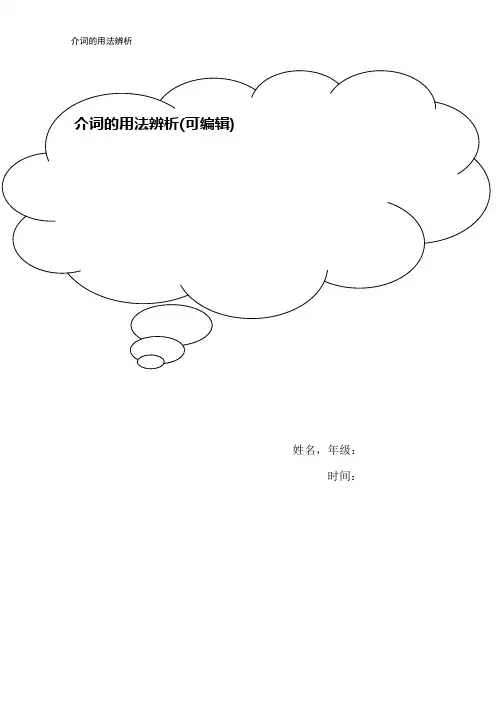
姓名,年级:时间:介词的用法辨析老师叮咛:李辉老师说,“一切的道理都比不过三个字,‘我愿意!’。
”学好英语有时其实很简单,只要你愿意去学,就会有结果。
学习介词就是这样的道理。
以下介词虽然大家都已经见过无数次,但是你是否真的学会了这些看似简单的单词呢?如果没有,你又是否愿意去学习这些呢?下面的内容就为大家讲解了介词的用法辨析。
本文经过了全网首席高考英语名师李辉老师团队高度认真的整理校对,无错、可信!可供全国各省高中生打印、学习、背诵!1.时间或地点介词in、on、at的用法区别:●表示时间时:in表示在一段时间里(在将来时句子中则表示在一段时间之后),on表示在具体的某一天或者某天的上下午等,at表示在某个时刻或者瞬间;●表示地点时:in表示在某个范围之内,on表示在某个平面上或与一个面相接触,at则表示在某个具体的场所或地点。
Eg:He was born on the morning of May 10th.(他出生于五月十日的早晨。
)I usually get up at 7:00 in the morning.(我通常在早上的七点钟起床。
)His glasses are right on his nose.(他的眼镜就架在他的鼻子上。
)He is at the cinema at the moment。
(此刻他正在电影院。
)2.after与in表示时间的用法区别:●“after+(具体时刻/从句)”表示“在…时刻之后”常用于一般时态;●“in+(一段时间)”表示“在(多久)之后”,常用于将来时态。
Eg:He said that he would be here after 6:00。
(他说他六点钟之后会来这儿。
)My father is coming back from England in about a month.(我父亲大约一个月以后从英国回来。
)3.since与for表示时间的用法区别:●“since+(具体时刻/that—从句)”表示“自从…起一直到现在”;●“for +(一段时间)”表示“总共有…之久",都常用于完成时态. Eg:Uncle Li has worked in this factory since 1970。
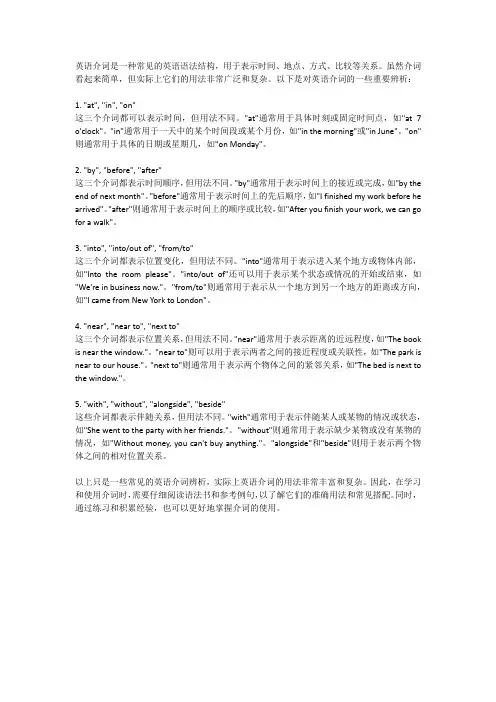
英语介词是一种常见的英语语法结构,用于表示时间、地点、方式、比较等关系。
虽然介词看起来简单,但实际上它们的用法非常广泛和复杂。
以下是对英语介词的一些重要辨析:1. "at", "in", "on"这三个介词都可以表示时间,但用法不同。
"at"通常用于具体时刻或固定时间点,如"at 7 o'clock"。
"in"通常用于一天中的某个时间段或某个月份,如"in the morning"或"in June"。
"on"则通常用于具体的日期或星期几,如"on Monday"。
2. "by", "before", "after"这三个介词都表示时间顺序,但用法不同。
"by"通常用于表示时间上的接近或完成,如"by the end of next month"。
"before"通常用于表示时间上的先后顺序,如"I finished my work before he arrived"。
"after"则通常用于表示时间上的顺序或比较,如"After you finish your work, we can go for a walk"。
3. "into", "into/out of", "from/to"这三个介词都表示位置变化,但用法不同。
"into"通常用于表示进入某个地方或物体内部,如"Into the room please"。

常用介词用法比较_介词(1)as , likeas 表示作为强调身份,like (介词)表示像As a teacher, he cares for these children.Like a teacher, he cares for these children.(2)with , inwith 表示外貌特征或附带的东西, 用作工具in 表示衣着用某语言, 在固定搭配中也可用inA man with dark glasses wanted to buy drinks.A man in black wanted to buy drinks.The boy is learning to write in pencil / with a pencil.He retold the text in English.(3)for , tofor表示为了.To 表示动作对象, 对, 向. 如:He would do anything for his motherland.Did you mention this to my father?你对我父亲提起过这件事吗?for 表示就某情况而说, to 表示一对某对象而言如:It’s quite warm today for February.就二月的天气,今天够暖和的。
What he told you just now was not new to me他刚才对你所说的话对我并不新鲜for 表示目的,用途。
与go, come 动词连用(4)except , besidesexcept 表示从总体中排除一部分, 与bat 同义,besides 表示除了一部分还有另一部分We all failed except him. 我们都失败了,但他没有。
He speaks German besides French.他懂法外还会讲英语。
(5)on ,about 关于on 表示这本书、文章、演说是严肃的学术性的,供专门研究这一问题的人阅读;about表示内容较为普通,不那么正式。
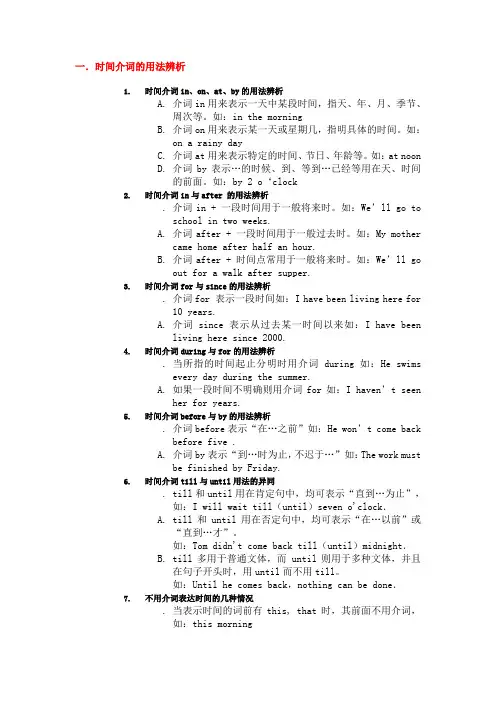
一.时间介词的用法辨析1.时间介词in、on、at、by的用法辨析A.介词in用来表示一天中某段时间,指天、年、月、季节、周次等。
如:in the morningB.介词on用来表示某一天或星期几,指明具体的时间。
如:on a rainy dayC.介词at用来表示特定的时间、节日、年龄等。
如:at noonD.介词by表示…的时候、到、等到…已经等用在天、时间的前面。
如:by 2 o‘clock2.时间介词in与after 的用法辨析.介词in + 一段时间用于一般将来时。
如:We’ll go toschool in two weeks.A.介词after + 一段时间用于一般过去时。
如:My mothercame home after half an hour.B.介词after + 时间点常用于一般将来时。
如:We’ll goout for a walk after supper.3.时间介词for与since的用法辨析.介词for 表示一段时间如:I have been living here for10 years.A.介词since 表示从过去某一时间以来如:I have beenliving here since 2000.4.时间介词during与for的用法辨析.当所指的时间起止分明时用介词during如:He swimsevery day during the summer.A.如果一段时间不明确则用介词for如:I haven’t seenher for years.5.时间介词before与by的用法辨析.介词before表示“在…之前”如:He won’t come backbefore five .A.介词by表示“到…时为止,不迟于…”如:The work mustbe finished by Friday.6.时间介词till与until用法的异同.till和until用在肯定句中,均可表示“直到…为止”,如:I will wait till(until)seven o'clock.A.till和until用在否定句中,均可表示“在…以前”或“直到…才”。
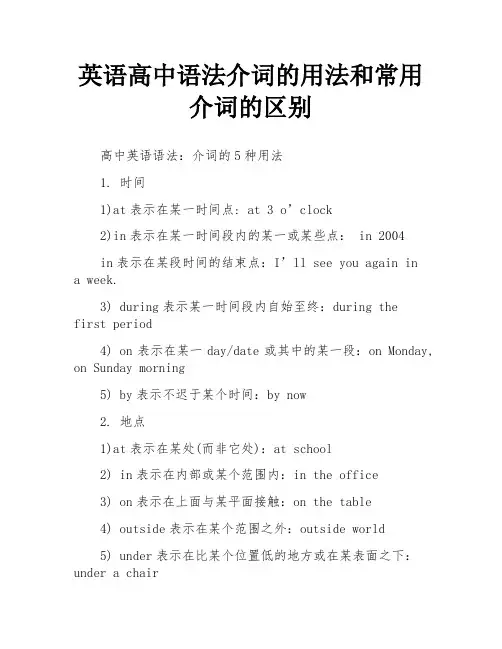
英语高中语法介词的用法和常用介词的区别高中英语语法:介词的5种用法1. 时间1)at表示在某一时间点: at 3 o’clock2)in表示在某一时间段内的某一或某些点: in 2004in表示在某段时间的结束点:I’ll see you again ina week.3) during表示某一时间段内自始至终:during thefirst period4) on表示在某一day/date或其中的某一段:on Monday, on Sunday morning5) by表示不迟于某个时间:by now2. 地点1)at表示在某处(而非它处):at school2) in表示在内部或某个范围内:in the office3) on表示在上面与某平面接触:on the table4) outside表示在某个范围之外:outside world5) under表示在比某个位置低的地方或在某表面之下:under a chair6) by表示靠近或接近:by the window3. 原因1)because of表示因为或以…为理由:because of my father2) for表示动作或活动的目的、目标或意图:for sale3) out of表示起源、来源或原因:out of duty4. 方式1)with表示以…方式:with skill2)in表示以某种方式: in French, in cash, in this way5. 方法1) by表示方法、手段: by the back road, by bus, by working hard2) on表示运送方式:on a train, on foot3) in表示途径或材料:in oils高中英语语法中常用介词的区别1、 at、in、on:如:常用词组有: at noon, at night表示时间的 at, in, on:at 表示片刻的时间,at 8 o’clock,at midnight, at the end of, at that time, at the beginning of, at the age of, at Christmas, at New Year 等。
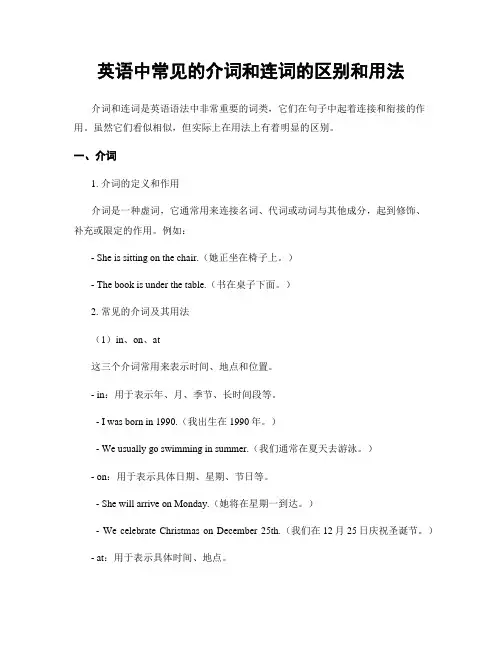
英语中常见的介词和连词的区别和用法介词和连词是英语语法中非常重要的词类,它们在句子中起着连接和衔接的作用。
虽然它们看似相似,但实际上在用法上有着明显的区别。
一、介词1. 介词的定义和作用介词是一种虚词,它通常用来连接名词、代词或动词与其他成分,起到修饰、补充或限定的作用。
例如:- She is sitting on the chair.(她正坐在椅子上。
)- The book is under the table.(书在桌子下面。
)2. 常见的介词及其用法(1)in、on、at这三个介词常用来表示时间、地点和位置。
- in:用于表示年、月、季节、长时间段等。
- I was born in 1990.(我出生在1990年。
)- We usually go swimming in summer.(我们通常在夏天去游泳。
)- on:用于表示具体日期、星期、节日等。
- She will arrive on Monday.(她将在星期一到达。
)- We celebrate Christmas on December 25th.(我们在12月25日庆祝圣诞节。
)- at:用于表示具体时间、地点。
- The meeting will start at 9 o'clock.(会议将在9点开始。
)- I met her at the library.(我在图书馆遇见了她。
)(2)with、without、by这三个介词常用来表示伴随、条件和方式。
- with:表示伴随、附带。
- She went to the party with her friends.(她和她的朋友们一起去了派对。
) - He always carries a book with him.(他总是随身带着一本书。
)- without:表示没有、不带。
- I can't live without you.(没有你我无法生活。
)- Please don't leave without saying goodbye.(请不要离开而不说再见。
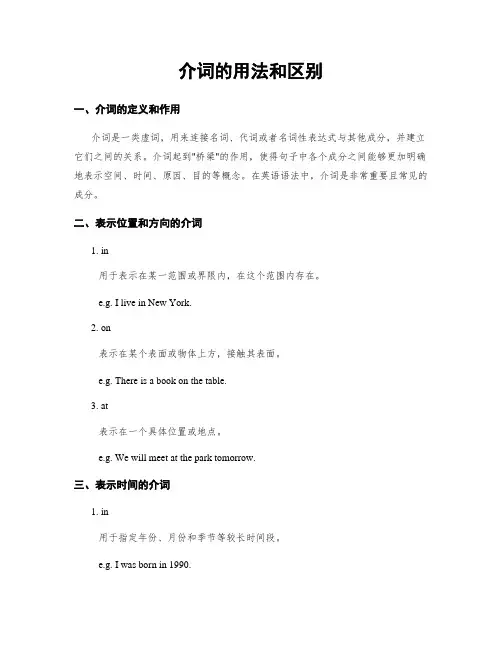
介词的用法和区别一、介词的定义和作用介词是一类虚词,用来连接名词、代词或者名词性表达式与其他成分,并建立它们之间的关系。
介词起到"桥梁"的作用,使得句子中各个成分之间能够更加明确地表示空间、时间、原因、目的等概念。
在英语语法中,介词是非常重要且常见的成分。
二、表示位置和方向的介词1. in用于表示在某一范围或界限内,在这个范围内存在。
e.g. I live in New York.2. on表示在某个表面或物体上方,接触其表面。
e.g. There is a book on the table.3. at表示在一个具体位置或地点。
e.g. We will meet at the park tomorrow.三、表示时间的介词1. in用于指定年份、月份和季节等较长时间段。
e.g. I was born in 1990.2. on常用于周末或某个具体日期。
e.g. Our concert is on Sunday.3. at常用于具体时刻、某时间点。
e.g. The meeting starts at 9 o'clock.四、表示方式和手段的介词1. by表示某种手段、方法或者交通工具。
e.g. I traveled to Beijing by train.2. with表示使用某物作为辅助工具或方式。
e.g. She opened the door with a key.五、表示原因和目的的介词1. for表示行动的目的,或是对某人或某事情做出解释。
e.g. I bought a gift for my sister's birthday.2. because of表示因果关系,强调结果导致原因。
e.g. The game was canceled because of the heavy rain.六、区别常用介词之间的用法1. in/intoin用于表示在某个范围内,有时候可以意味着状态;into表示进入一个新的地方或状态。
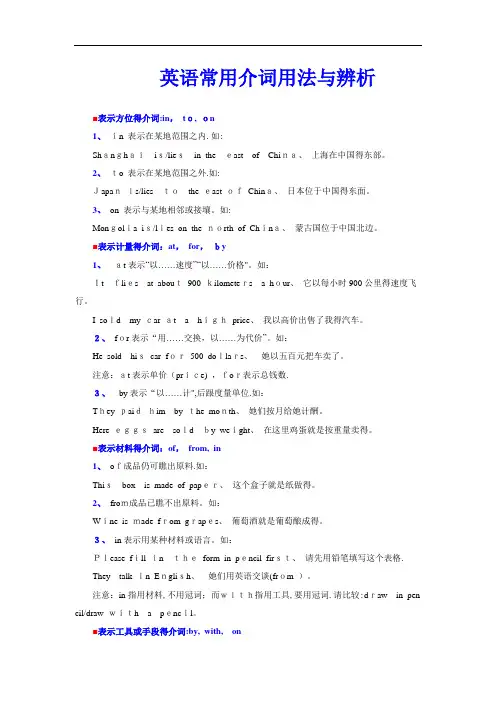
英语常用介词用法与辨析■表示方位得介词:in,to, on1、in 表示在某地范围之内.如:Shanghaiis/liesin theeast of China、上海在中国得东部。
2、to 表示在某地范围之外.如:Japanis/liestothe east ofChina、日本位于中国得东面。
3、on 表示与某地相邻或接壤。
如:Mongolia is/lies on the north of China、蒙古国位于中国北边。
■表示计量得介词:at,for,by1、at表示“以……速度”“以……价格"。
如:Itflies at about900 kilometers a hour、它以每小时900公里得速度飞行。
I sold my car at a highprice、我以高价出售了我得汽车。
2、for表示“用……交换,以……为代价”。
如:He sold hiscar for500 dollars、她以五百元把车卖了。
注意:at表示单价(price) ,for表示总钱数.3、by表示“以……计",后跟度量单位.如:They paidhim by the month、她们按月给她计酬。
Here eggsare soldby weight、在这里鸡蛋就是按重量卖得。
■表示材料得介词:of,from, in1、of成品仍可瞧出原料.如:Thisbox is made of paper、这个盒子就是纸做得。
2、from成品已瞧不出原料。
如:Wine is made from grapes、葡萄酒就是葡萄酿成得。
3、in表示用某种材料或语言。
如:Please fill intheform in pencil first、请先用铅笔填写这个表格.They talk in English、她们用英语交谈(from )。
注意:in指用材料,不用冠词;而with指用工具,要用冠词.请比较:draw in pen cil/draw with a pencil。
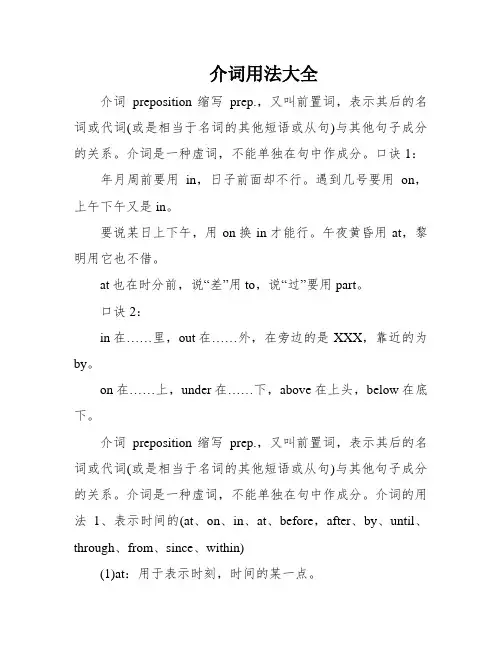
介词用法大全介词preposition缩写prep.,又叫前置词,表示其后的名词或代词(或是相当于名词的其他短语或从句)与其他句子成分的关系。
介词是一种虚词,不能单独在句中作成分。
口诀1:年月周前要用in,日子前面却不行。
遇到几号要用on,上午下午又是in。
要说某日上下午,用on换in才能行。
午夜黄昏用at,黎明用它也不借。
at也在时分前,说“差”用to,说“过”要用part。
口诀2:in在……里,out在……外,在旁边的是XXX,靠近的为by。
on在……上,under在……下,above在上头,below在底下。
介词preposition缩写prep.,又叫前置词,表示其后的名词或代词(或是相当于名词的其他短语或从句)与其他句子成分的关系。
介词是一种虚词,不能单独在句中作成分。
介词的用法1、表示时间的(at、on、in、at、before,after、by、until、through、from、since、within)(1)at:用于表示时刻,时间的某一点。
XXX在中午XXX在夜间XXX目前(2)on:用于星期,某天,某一天的上午、下午、晚上(指具体的某一天时,一律用) onsunday在星期天XXX在星期天的上午on march 8在3月8日(3)in:用于透露表现周、月、季候、年、泛指上午、下午、清晨。
in 1999在1999年XXX在11月份in summer在夏季in XXX在下午i think he will be back in an hour。
我想他一小时后就会回来。
i heard that she would be back in a month.我听说她一个月后回来的。
by the time i arrived,she had already gone。
在我到达之前,她已经走了。
XXX-four hours without rest。
XXX常常工作24小时而不休息。
during the lifetime of one man,XXX。
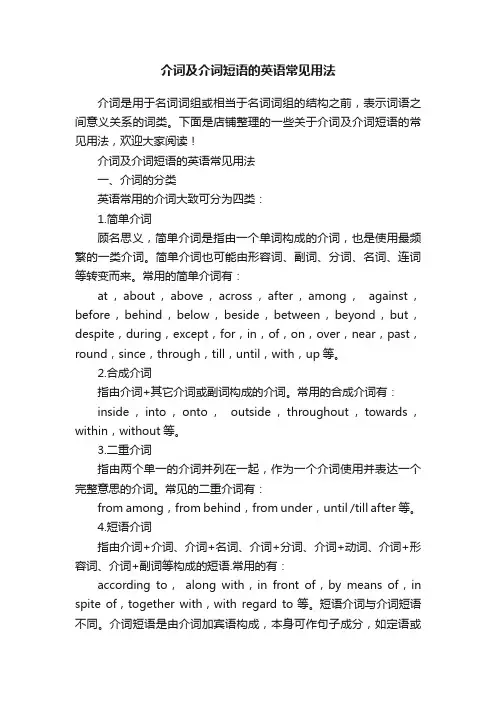
介词及介词短语的英语常见用法介词是用于名词词组或相当于名词词组的结构之前,表示词语之间意义关系的词类。
下面是店铺整理的一些关于介词及介词短语的常见用法,欢迎大家阅读!介词及介词短语的英语常见用法一、介词的分类英语常用的介词大致可分为四类:1.简单介词顾名思义,简单介词是指由一个单词构成的介词,也是使用最频繁的一类介词。
简单介词也可能由形容词、副词、分词、名词、连词等转变而来。
常用的简单介词有:at,about,above,across,after,among,against,before,behind,below,beside,between,beyond,but,despite,during,except,for,in,of,on,over,near,past,round,since,through,till,until,with,up等。
2.合成介词指由介词+其它介词或副词构成的介词。
常用的合成介词有:inside,into,onto,outside,throughout,towards,within,without等。
3.二重介词指由两个单一的介词并列在一起,作为一个介词使用并表达一个完整意思的介词。
常见的二重介词有:from among,from behind,from under,until /till after等。
4.短语介词指由介词+介词、介词+名词、介词+分词、介词+动词、介词+形容词、介词+副词等构成的短语.常用的有:according to,along with,in front of,by means of,in spite of,together with,with regard to等。
短语介词与介词短语不同。
介词短语是由介词加宾语构成,本身可作句子成分,如定语或状语等,可单独使用;而短语介词是用作介词的短语,不可独立使用,本身不能作句子成分,后面要跟名词、动名词或代词等。
英语介词讲解介词(preposition)是一种用来连接名词、代词或名词短语与其他词或短语的词类,在句子中常常表示位置、方向、时间、关系等。
以下是一些常见的英语介词及其用法:1.in:表示在某个位置、地点、范围或状态之内。
例如:in the room(在房间里)、in London(在伦敦)、in the book(在书中)等。
2.on:表示在某个平面、表面、方向或日期上。
例如:on the table(在桌子上)、on the wall(在墙上)、on Monday(在星期一)等。
3.at:表示在某个点、时间、活动或事件上。
例如:at the park(在公园)、at 8 o'clock(在8点)、at the party(在聚会上)等。
4.by:表示通过某种方式、手段或时间。
例如:by car(乘车)、by email (通过电子邮件)、by Friday(到星期五)等。
5.for:表示为某个目的、目标或时间段。
例如:for you(为你)、for two hours(两个小时)、for breakfast(作为早餐)等。
6.to:表示朝向某个地点、目的地或对象。
例如:to the park(到公园)、to the store(到商店)、to you(给你)等。
7.from:表示起点、来源或运动方向。
例如:from the house(从房子里)、from London(从伦敦)、from Monday to Friday(从星期一到星期五)等。
8.with:表示伴随、附带或使用某物。
例如:with my friend(和我的朋友一起)、with a pen(用一支笔)、with pleasure(乐意)等。
9.about:表示关于某个主题、话题或方面。
例如:about the book(关于这本书)、about the weather(关于天气)、talk about(谈论)等。
10.of:表示属于、关于或由某物组成。
英语常用介词用法与辨析■表示方位的介:in,to, onin表示在某地范之内。
如:Shanghaiis/liesintheeastofChina. 上海在中国的部。
to表示在某地范之外。
如:Japanis/liestotheeastofChina. 日本位于中国的面。
on表示与某地相或接壤。
如:Mongoliais/liesonthenorthofChina. 蒙古国位于中国北。
■表示量的介:at,for,byat表示“以⋯⋯速度〞“以⋯⋯价格〞。
如:Itfliesatabout900kilometersahour. 它以每小900公里的速度行。
Isoldmycaratahighprice. 我以高价出售了我的汽。
for表示“用⋯⋯交,以⋯⋯代价〞。
如:Hesoldhiscarfor500dollars. 他以五百元把了。
注意:at表示价(price),for表示数。
by表示“以⋯⋯〞,后跟度量位。
如:Theypaidhimbythemonth. 他按月他酬。
Hereeggsaresoldbyweight. 在里蛋是按重量的。
■表示材料的介:of,from,inof成品仍可看出原料。
如:Thisboxismadeofpaper.个盒子是做的。
from成品已看不出原料。
如:Wineismadefromgrapes. 葡萄酒是葡萄成的。
in表示用某种材料或言。
如:Pleasefillintheforminpencilfirst. 先用笔填写个表格。
TheytalkinEnglish.他用英交(from 。
注意:in指用材料,不用冠;而with指用工具,要用冠。
比:drawinpencil/drawwithapencil。
■表示工具或手段的介: by,with,onby用某种方式,多用于交通。
如bybus乘公共汽,bye-mail.通子件。
注意:表示搭乘交通工具,用 by不用冠,用in要用冠。
比:Iwenttherebybus/inabus. 我是坐公共汽去的那儿。
英语介词用法大全一、介词preposition缩写prep,又叫前置词,表示其后的名词或代词(或是相当于名词的其他短语或从句)与其他句子成分的关系。
介词是一种虚词,不能单独在句中作成分。
二. 常用介词用法区分:1、in, on, to表示地理位置:in表示在某范围内,on指与什么毗邻,to指在某环境范围之外;2、on, in表示“在…上”时:on只表示在某物的表面上,in表示占去某物一部分;3、through, across都表示“穿过”时:through表示从内部通过,与in有关,across表示在表面上通过,与on有关;4、since, from表示表示时间时:since 指从过去到现在的一段时间,和完成时连用,from指从时间的某一点开始;5、in, on, at表示时间时:at表示片刻的时间,in表示一段的时间,on总是与日子有关;6、in, after表示时间时:in指在一段时间之后,after表示某一具体时间点之后或用在过去时的一段时间中;7、about, on表示“关于”时:about指涉及到,on指专门论述;8、besides与except表示“除了”:besides指“除了…还有再加上”,except指“除了,减去什么”,不放在句首;9、between与among表示“在两者之间”:between表示在两者之间,among用于三者或三者以上的中间;10、in, with表示“用”时:with表示具体的工具,in表示材料,方式,方法,度量,单位,语言,声音;11、in与into表示在里面:in通常表示位置(静态),into表示动向,不表示目的地或位置。
12、as与like:as意为“作为,以…地位或身份”,like为“象…一样”,指情形相似;三、介词用法口诀1、年月周前要用in,遇到几号用on,上午下午又是in.要说某日上下午,on换成in,午夜黄昏用at,黎明用它也不借。
at也在时分前,说“差”要用to,说“过”用part。
超全英语介词用法归纳总结超全英语介词用法归纳总结,我们一起来学习吧,下面就和大家分享,来欣赏一下吧。
超全英语介词用法归纳总结在英语中,介词(preposition)虽然是一种小词,但在作用和运用上的复杂性却不可小看!可以毫不夸张地说,离开了介词的中介或连接作用,就无法表达某些最基本的思想或概念。
在阅读理解和完形填空中,对于介词基本含义的理解,对于能否正确理解文意,起着十分重要的作用!介词虽小,不可小觑!小简老师已为大家备好电子打印版,文末附电子打印版免费领取方式,想要获取电子打印版请拉到文末。
常用介词基本用法辨析表示方位的介词: in, to, on1. in 表示在某地范围之内。
Shanghai is/lies in the east of China. 上海在中国的东部。
2. to 表示在某地范围之外。
Japan is/lies to the east of China. 日本位于中国的东面。
3. on 表示与某地相邻或接壤。
Mongolia is/lies on the north of China. 蒙古国位于中国北边表示计量的介词: at, for, by1. at 表示“以……速度”“以……价格”。
It flies at about 900 kilometers an hour. 它以每小时900公里的速度飞行。
I sold my car at a high price. 我以高价出售了我的汽车。
2. for 表示“用……交换,以……为代价”。
He sold his car for 500 dollars. 他以五百元把车卖了。
注意:at表示单价(price) ,for表示总钱数。
3. by 表示“以……计”,后跟度量单位。
They paid him by the month. 他们按月给他计酬。
Here eggs are sold by weight. 在这里鸡蛋是按重量卖的。
表示材料的介词: of, from, in1. of 成品仍可看出原料。
英语常用介词用法与辨析作者: admin来源: 网络文章时间: 2016-07-05一、表示方位的介词:in, to, on1. in 表示在某地范围之内。
如:Shanghai is/lies in the east of China. 上海在中国的东部。
2. to 表示在某地范围之外。
如:Japan is/lies to the east of China. 日本位于中国的东面。
3. on 表示与某地相邻或接壤。
如:Mongolia is/lies on the north of China. 蒙古国位于中国北边。
二、表示计量的介词:at, for, by1. at表示“以……速度”“以……价格”。
如:It flies at about 900 kilometers an hour. 它以每小时900公里的速度飞行。
I sold my car at a high price. 我以高价出售了我的汽车。
2. for表示“用……交换,以……为代价”。
如:He sold his car for 500 dollars. 他以五百元把车卖了。
注意:at表示单价(price) ,for表示总钱数。
3. by表示“以……计”,后跟度量单位。
如:They paid him by the month. 他们按月给他计酬。
Here eggs are sold by weight. 在这里鸡蛋是按重量卖的。
三、表示材料的介词:of, from, in1. of成品仍可看出原料。
如:This box is made of paper. 这个盒子是纸做的。
2. from成品已看不出原料。
如:Wine is made from grapes. 葡萄酒是葡萄酿成的。
3. in表示用某种材料或语言。
如:Please fill in the form in pencil first. 请先用铅笔填写这个表格。
They talk in English. 他们用英语交谈。
英语常用介词用法与辨析■表示方位的介词:in, to, on1. in 表示在某地范围之内。
如:Shanghai is/lies in the east of China. 上海在中国的东部。
2. to 表示在某地范围之外。
如:Japan is/lies to the east of China. 日本位于中国的东面。
3. on 表示与某地相邻或接壤。
如:Mongolia is/lies on the north of China. 蒙古国位于中国北边。
■表示计量的介词:at, for, by1. at表示“以……速度”“以……价格”。
如:It flies at about 900 kilometers a hour. 它以每小时900公里的速度飞行。
I sold my car at a high price. 我以高价出售了我的汽车。
2. for表示“用……交换,以……为代价”。
如:He sold his car for 500 dollars. 他以五百元把车卖了。
注意:at表示单价(price) ,for表示总钱数。
3. by表示“以……计”,后跟度量单位。
如:They paid him by the month. 他们按月给他计酬。
Here eggs are sold by weight. 在这里鸡蛋是按重量卖的。
■表示材料的介词:of, from, in1. of成品仍可看出原料。
如:This box is made of paper. 这个盒子是纸做的。
1 / 152. from成品已看不出原料。
如:Wine is made from grapes. 葡萄酒是葡萄酿成的。
3. in表示用某种材料或语言。
如:Please fill in the form in pencil first. 请先用铅笔填写这个表格。
They talk in En. 他们用英语交谈(from 。
注意:in指用材料,不用冠词;而with指用工具,要用冠词。
请比较:draw in pencil/draw with a pencil。
■表示工具或手段的介词:by, with, on1. by用某种方式,多用于交通。
如by bus乘公共汽车,by e-mail. 通过电子邮件。
注意:表示搭乘交通工具时,用by时不用冠词,用in时要用冠词。
请比较:I went there by bus/in a bus. 我是坐公共汽车去的那儿。
2. with表示“用某种工具”。
如:He broke the window with a stone. 他用石头把玻璃砸坏了。
注意:with表示用某种工具时,必须用冠词或物主代词。
3. on表示“以……方式”,多用于固定词组。
They talked on the telephone. 他们通过电话进行交谈。
She learns English on the radio/on TV. 她通过收音机/电视学英语。
■表示关于的介词:of, about, on1. of仅是提到或谈到过某人或某事。
如:He spoke of the film the other day. 他前几天提到了这部影片。
2 / 15He thought about this matter yesterday. 他昨天考虑了这件事。
2. about指“关于”某人或某事物的较详细的情况。
如:Can you tell me something about yourself? 你能告诉我一些关于你自己的事情吗?3. on指“关于”学术性的或严肃的事。
如:It's a textbook on the history of china. 它是一本有关中国历史的教科书。
■表原因或理由的介词:for, at, from, of, with, by, because of1. for表示原因,常与sorry, famous, punish, praise, thank, blame等词连用。
如:I am sorry for what I said to you. 我后悔不该对你讲那些话。
2. at指情感变化的原因,意为“因听到或看到而……”。
如:He was surprised at the news. 听到这消息他大吃一惊。
3. from指“外在的原因”,如受伤、车祸等。
如:He died from the wound. 他因受伤而致死。
4. of指“内在的原因”,如病、饿等。
如:The old man died of hunger. 老人死于饥饿。
5. with指生理上或情感上的由外界到内心的原因。
如:Hearing the news, he jumped with joy. 他们听到这个消息,欣喜若狂。
He was shaking with anger. 他气得浑身发抖。
6. by表示外部的,尤其是暴力的或无意中造成某种结果的原因。
Her body was bent by age. 他因年老背弯了。
3 / 15She took your umbrella by mistake. 我因弄错拿了你的雨伞。
7. because of 表示引起结果的直接原因。
如:He retired last month because of illness/because he ill.8. owing to多表示引起某不良后果的原因。
如:9. thanks to表示引起某种幸运结果的原因,常译为“幸亏……,多亏……”。
如:Thanks to John, we won the game. 多亏约翰,我们才赢了这场比赛。
10. out of表示动机的起因,常译为“出于……”。
如:He asked the question out of curiosity. 他出于好奇才问了那个问题。
11. through多表示因局部而影响全局的原因。
如:The war was lost through bad organization. 战争因组织不周而失败了。
■表示好像或当作的介词:like, as1. like表示“像……一样”,其实不是。
如:Peter the Great, like his country, was strong and proud. 彼得大帝像他的国家一样强健和自豪。
2. as表示“作为,以……身份”,其实也是。
如:He talked to me as a father. 他以父亲的身份跟我谈话。
注:as作连词时,可表示“好像……”。
如:The work is not so difficult as youimagin这工作不像你想像的那么困难。
■表示支持或反对的介词:against, foragainst反对,for支持,互为反义词。
如:Are you for my idea or against it? 你赞同还是反对我的想法?4 / 15■表示除某人某物外的介词:besides, except1. besides是包括后面所提人或物在内的“除……外,还”。
如:Thirty students went to the cinema besides him. 除他以外,还有30个学生去看了电影。
(他和另外30人都去了)He is interested in tennis besides(=as well as)football. 除了足球,他还对网球感兴趣。
2. except是指不包括后面所提人或物在内的“除去”。
如(from :Everyone is excited except me. 除我以外的每个人都很激动。
(他们激动,而我却不激动)All the visitors are Japanese except him. 除他以外的所有游客都是日本人。
(其他人是日本人,可他不是)注意:(A) except通常与表示全体的all, every连用;若与other连用,只能用besides。
如:He had other people to take care of besides me. 除我之外,他还要照顾别人。
(B) except是排除同类;而except for是排除非同类,常在说明基本情况后,从细节上加上修正。
如:但except for也可代替except,特别是在句首时,因为except是不能用于句首的。
如:Except George, you can all go. 除乔治外,你们都可以去。
英语基础语法·介词1. 介词的定义介词是一种用来表示词与词, 或者词与句之间的关系的词,在句中不能单独作句成分。
介词一定要有宾语,充当宾语的一般有名词、代词或相当于名词的其它词、短语或句子,短语或从句。
5 / 152. 介词的种类(1)简单介词,如at, in off, on, by, to, with等。
(2)合成介词,如into, inside, within, throughout等。
(3)短语介词,如according to, because of, in addition to, in front of, in spite of等。
(4)二重介词,如from behind, from among, until after, at about等。
3. 介词的宾语(1)名词:Let's go for a walk along the river. 咱们到江边散散步。
(2)代词:He's standing in front of me. 我站在我前面。
(3)形容词:Her pronunciation is far from perfect. 她的语音远不是完美的。
注:有的形容词前可看作是省略了being。
(4)动名词:He's good at drawing.他善长绘画。
(5)过去分词:I took it for granted that she was for England.我还以为她是英国的。
注:过去分词作介词宾语只限于take…for granted 结构和用于regard…as后。
(6)不定式:I had no choice but to lie down. 除了躺下外我别无选择。
She did nothing but cry.她只是哭。
注:介词后通常是不能用不定式作宾语的,只有表示“除……外”的but,except 等个别介词能接不定式作宾语。
前面有行为动词do时,不定式不用to,否则要带to。
(7)疑问词+不定式:I don't know how to improve my English.我不知道如何提高我的英语水平。
6 / 15(8)副词:I didn't know it until recently. 直到最近我才知道此事。